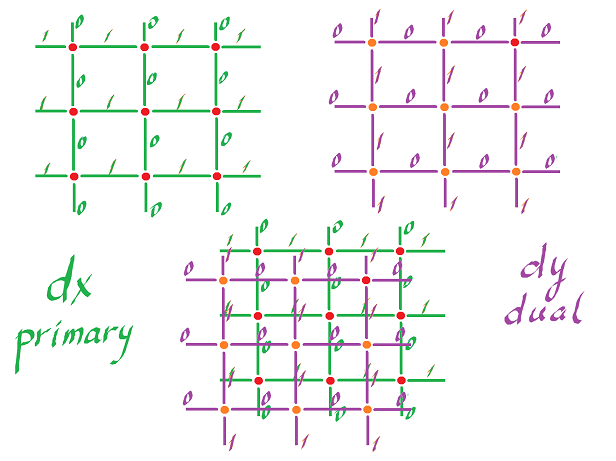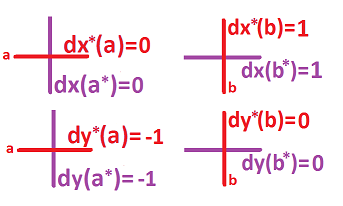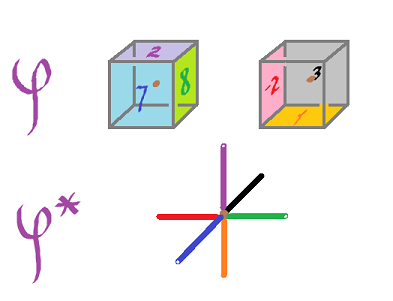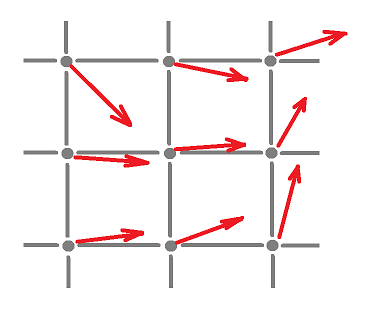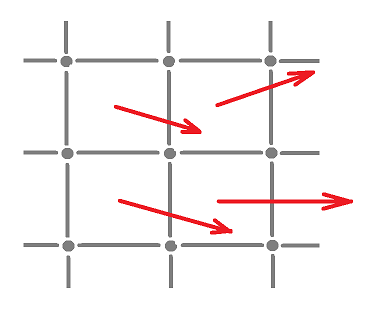This site is being phased out.
Discrete Hodge star operator
Hodge star is a linear operator on the cochain complex: $$\star : C^k(K) \rightarrow C^{n-k}(K^*),$$ where $K^*$ is the Hodge dual of the cubical complex $K$.
The dual $\varphi^*$ of form $\varphi$ is computed according to the formula: $$\varphi^*(\tau) = \varphi(\tau^*),$$ for any chain $\tau$.
Practically this means that:
- we have form $\varphi$ presented by its values on the primary grid $K$;
- we go through the dual grid, match its cells one by one back to the corresponding primary cells, and then copy the corresponding values to each dual cell.
This procedure is illustrated below.
For $n=2$, let's verify $(dx)^* = dy$, $(dy)^*=-dx$.
This is all we have geometrically:
Just turn $90^o$ (counterclockwise) and assign the same number. In general the sign may change as you turn in the same direction.
Now the algebra. By the definition above: $$(dx)^*(\sigma) = dx(\sigma^*),$$ where $\sigma$ is a dual cell and $\sigma^*$ is a primary cell.
In particular, suppose
- $a$ is a horizontal dual cell,
- $b$ is a vertical dual cell.
Then
- $c=-a^*$ is a vertical primary cell,
- $d=b^*$ is a horizontal primary cells.
The negative sign ensures that the cell is oriented in the positive direction.
Then:
- $(dx)^*(a) = dx(a^*)=dx(-c)=-dx(c)=0,$
- $(dx)^*(b) = dx(b^*)=dx(d)=1.$
That's $dy$ on the dual grid. Next,
- $(dy)^*(a) = dy(a^*)=dy(-c)=-dy(c)=-1,$
- $(dy)^*(b) = dy(b^*)=dy(d)=0.$
That's $-dx$ on the dual grid.
Another example in dimension $2$. We have here $$\varphi^*(\tau) = \varphi(\tau^*),$$ where $\varphi$ is $k$-form, $\tau$ is $(2-k)$-cell.
Here's a $1$-form $\varphi$:
Find $1$-form $\varphi^*$:
Next an example in dimension $3$.
Consider the dual grid in ${\bf R}^3$ and the duality of cells:
Here we have $$\varphi^*(\tau) = \varphi(\tau^*),$$ where $\varphi$ is $k$-form, $\tau$ is $(3-k)$-cell. Let $\varphi$ be a $2$-form and so $\varphi^*$ is a $1$-form.
We assume that there are these $6$ faces with non-zero values.
Shown are the corresponding "non-zero" cells for $\varphi^*$.
Verify the values of the star operator in dimension $3$: $$\begin{align*} 1^* &= dx \hspace{1pt} dy \hspace{1pt} dz \\ (dx)^* &= dy \hspace{1pt} dz \\ (dy)^* &= dz \hspace{1pt} dx \\ (dz)^* &= dx \hspace{1pt} dy \\ (dx \hspace{1pt} dy)^* &= dz \\ (dy \hspace{1pt} dz)^* &= dx \\ (dz \hspace{1pt} dx)^* &= dy \\ (dx \hspace{1pt} dy \hspace{1pt} dz)^* &= 1 \end{align*}$$
Note: As natural discretization of a vector field we have considered a "vector-valued" $0$-form, in the sense that there is a vector assigned to each $0$-cell:
For modelling of motion of a particle, however, one has to interpolate the vector field to the rest of the cells.
On the dual grid this is what a "vector-valued" $0$-form looks like:
This interpretation comes from applications. Given a continuous vector field, one samples or averages the values for each $2$-cell and record it as the value at the cell.
Hodge star as a linear operator on cochains
Recall that the discrete Hodge duality is an operator on chains: $$\star :C_k(K)\rightarrow C_{n-k}(K^*).$$ Now the Hodge duality of forms is the dual of this operator: $$\star :C^k(K)\rightarrow C^{n-k}(K^*).$$
Let's consider its properties. They match those of the operator on de Rham complex $\Omega$.
The star operator is an isomorphism.
For $n$ the dimension of the space, the (non-commutative) Hodge duality diagram still applies: $$ \newcommand{\ra}[1]{\!\!\!\!\!\!\!\xrightarrow{\quad#1\quad}\!\!\!\!\!} \newcommand{\da}[1]{\left\downarrow{\scriptstyle#1}\vphantom{\displaystyle\int_0^1}\right.} \newcommand{\la}[1]{\!\!\!\!\!\!\!\xleftarrow{\quad#1\quad}\!\!\!\!\!} \newcommand{\ua}[1]{\left\uparrow{\scriptstyle#1}\vphantom{\displaystyle\int_0^1}\right.} % \begin{array}{ccccccccccc} & C ^{0}(K)& \ra{d} & ... & \ra{d}& C ^k(K) & \ra{d} & C ^{k+1}(K) & \ra{d} &...& \ra{d} & C ^{n}(K)\\ & \da{\star} & & & & \da{\star} & \ne & \da{\star} & & & & \da{\star} \\ & C ^{n}(K^*)& \la{d}& ... & \la{d}& C ^{n-k}(K^*)& \la{d} & C ^{n-(k+1)}(K^*)& \la{d} &...& \la{d} & C ^{0}(K^*) \\ \end{array} $$ But here the top and bottom rows do not represent the same complex anymore. This is the reason why the conclusion about the "mirror" symmetry that we made about $\Omega$ isn't possible. The issue is handled via Poincare duality of homology vs cohomology.
Just as with the continuous version we apply the Hodge duality to define the second derivative.
We
- "dualize" the exterior derivative $df$,
- take the exterior derivative of the result, and then
- "dualize" it back:
$$f \stackrel{d}{\longmapsto} df = f' dx \stackrel{\star}{\longmapsto} f' \stackrel{d}{\longmapsto} f' ' dx \stackrel{\star}{\longmapsto} f' '.$$
So, for a $0$-form this is, again, a $0$-form. For all cochains we use the sum of the two "dualized second derivatives" $$\star d \star d \varphi + d \star d \star \varphi$$ to define the analogue of the Laplacian for differential forms.
